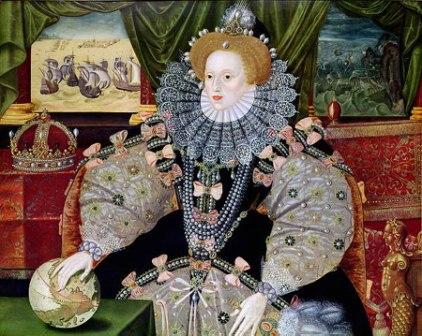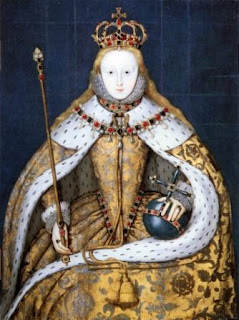As an American, it is hard to find direct ties between Elizabeth and the "New World". Of course, there are the obvious connections, like Elizabethan exploration, Virginia/Roanoke, and the experimental settlement of her successor, Jamestown. But other than than that there are very few! But upon casting my net a little wider, I can recover a whole tradition of literary tributes and allusions to England's most famous monarch.
Today I want to share with you a poem that I first came across when I was studying literature in college. The poem is a tribute to Queen Elizabeth I and her legacy by a British woman, Anne Bradstreet, who settled in New England in 1630. Anne was born Anne Dudley, but she became a Bradstreet when she married Simon Bradstreet at the age of 16 in 1628. Simon was a Cambridge graduate who was nine years her senior. Both the Dudley's and the Bradstreet's were Puritans who journeyed to America for religious freedom. Anne became a prolific writer in her new country. She chronicled spiritual struggles, the tragic deaths of her children, and wrote about her love for her husband while surviving harsh weather, famine, and the destruction of her home by fire.
 |
| A depiction of Anne Bradstreet at her writing desk. Picture acquired through Wikimedia Commons. Image public domain. |
In 1650, Anne wrote a poem to honor Queen Elizabeth I, whose reign would have been in the recent memory of her parents and grandparents. Undoubtedly, Anne had listened to stories as a child portraying Queen Elizabeth as the utmost example of Christian learning and piety; however, it is somewhat ironic that any Puritan would sing such high praises of the Protestant queen, since Elizabeth herself was always wary of extremism on either side of the religious spectrum, be it the fervent Catholics or the strict Puritans.
Without further ado, I share with you Bradstreet's tributary poem, an homage from one strong Protestant woman to another. Bradstreet writes in the traditional style of verse, and also includes many classical allusions. Amidst the formality of the structure, I feel Bradstreet is able to convey a genuine feeling of admiration and affection for Queen Elizabeth, whose achievements she calls on all to recognize. The explanations in italicized parenthesis are my own, to provide greater clarity.
 |
| The Rainbow Portrait of Queen Elizabeth I, attributed to both Isaac Oliver and Marcus Gheeraerts, c. 1600-1602. Inscribed on the left-hand side of the portrait is the Latin phrase NON SINE SOLE/IRIS, or "No Rainbow without the Sun". The sun, of course, is Queen Elizabeth herself, while the rainbow is the hope and peace she has brought to her realm. On her fabric of her dress are symbolic eyes, ears and mouths, to convey that this queen is all-knowing and all-powerful. Interestingly, Elizabeth would nick-name members of her Privy-council and her friends, and some of them where called after body parts. For instance, Elizabeth was known to call the Earl of Leicester her "eyes". This painting is one of my personal favorites of the queen, and it is also the perfect example of the Queen controlling how her image was portrayed; by royal decree, she must always appear youthful, even immortal, so as to deter talk of her declining health and the succession. The portrait is now on display in Hatfield House. Picture acquired through Wikimedia Commons. Image public domain. |
In Honor of That High and Mighty Princess Queen Elizabeth of Happy Memory
The Proem (a brief introductory verse)
Although, great Queen, thou now in silence lie
Yet thy loud herald Fame doth to the sky
Thy wondrous worth proclaim in every clime,
And so hath vowed while there is world or time.
So great's thy glory and thine excellence,
The sound thereof rapts (holds the complete attention of) every human sense,
That men account it no impiety
To say thou wert a fleshly deity.
Thousands bring offerings (though out of date)
Thy world of honors to accumulate;
'Mongst hundred hecatombs (Honorary tributes) of roaring verse
Mine bleating stands before thy royal hearse
Thou never didst nor canst thou now disdain
T'accept the tribute of a loyal brain.
Thy clemency did erst esteem as much
The acclamations of the poor as rich,
Which makes me deem my rudeness is no wrong,
Though I resound thy praises 'mongst the throng.
The Poem
No Phoenix pen, nor Spenser's poetry, (Edmund Spenser 1552-1599, author of The Faerie Queen)
No Speed's nor Camden's learned history, (John Speed 1542-1629, Wm.Camden 1551-1623; English historians)
Eliza's works, wars, praise, can e'er compact (summarize) ;
The world's the theatre where she did act.
No memories nor volumes can contain
The 'leven Olympiads of her happy reign, (the 4-yr period between Olympic games; thus asserting correctly that Elizabeth ruled for 44 yrs.)
Who was so good, so just, so learned, so wise,
From all kings on earth she won the prize.
Nor say I more than duly is her due,
Millions will testify that this is true.
She hath wiped off th' aspersion of her sex,
That women wisdom lack to play the rex (Latin for 'king')
Spain's monarch says not so, nor yet his host (Philip II and his army; Elizabeth's Navy defeated his Spanish Armada)
She taught them better manners, to their cost.
The Salic law (ancient law used in France and Spain to forbid women to inherit land, thus preventing them to rule in their own right) in force now had not been,
If France had ever hoped for such a queen.
But can you, doctors (scholars), now this point dispute.
She's argument enough to make you mute.
Since first the Sun did run his ne'er run race,
And earth had, once a year, a new old face,
Since time was time, and unmanly man,
Come show me such a phoenix if you can.
Was ever people better ruled than hers?
Was ever land more happy freed from stirs (conflict and war)
Did ever wealth in England more abound?
Her victories in foreign coasts resound;
Ships more invincible than Spain's, her foe,
She wracked, she sacked, she sunk his Armado;
Her stately troops advanced to Lisbon's wall,
Don Anthony1 in's right there to install.
She frankly helped Frank's brave distress'ed king2; (The references are to 1. Philip's unsuccessful rival to the throne of Portugal, supported by England & France 2. Henri IV, who came to the French throne in 1589 & was aided with money & arms by Elizabeth to fight Catholic rebels backed by Spain.)
The states united now her fame do sing.
She their protectrix was; they well do know
Unto our dreaded virago, what they owe,
Her nobles sacrificed their noble blood,
Nor men nor coin she spared to do them good.
The rude untam'ed Irish she did quell;
Before her picture the proud Tyrone fell (The Earl of Tyrone, assisted by Spain to lead the Irish in rebellion against English rule; defeated at Kinsale).
Had ever prince such counsellors as she?
Herself Minerva caused them so to be (Minerva is the Roman name for the goddess Athena, who was goddess of wisdom, war, and crafts).
Such captains and such soldiers never seen,
As were the subjects of our Pallas queen (a prefix for Athena).
Her seamen though all straits the world did round;
Terra incognita (Latin for 'unknown land') might know the sound.
Her Drake1 came laden home with Spanish gold;
Her Essex2 took Cadiz, their Hurculean hold (1.Francis Drake, English admiral, explorer and privateer 1540-1596. 2. reference to Robert Devereux Earl of Essex).
But time would fail me, so my tongue would too,
To tell of half she did, or she could do.
Semiramis to her is but obscure, (reference to the Semi-legendary Assyrian warrior-queen)
More infamy than fame she did procure.
She build her glory but on Babel's walls,
World's wonder for a while, but yet it falls.
Fierce Tomris (Cyrus' headsman) Scythian's queen, (Tomyris, Scythian warrior who beheaded Cyrus, the founder of the Persian Empire, on the battlefield. Scythians, like the Celts, did not consider it unnatural for women to fight. It has been suggested that the Scythina women-warriors inspired the legends of the Amazons.)
Had put her harness off, had she but seen
Our Amazon in th' Camp of Tilbury, (Site of Elizabeth's famous address to her troops on the eve of the invasion of the Spanish Armada.)
Judging all valor and all majesty
Within that princess to have residence,
And prostrate yielded to her excellence,
Dido1, first foundress of proud Carthage walls
(Who living consummates her funerals), (1. Queen of Carthage; upon her abandonment by her lover Aeneas, Dido threw herself onto her own funeral pyre in despair.)
A great Eliza, but compared with ours,
How vanisheth her glory, wealth, and powers.
Profuse, proud Cleopatra, whose wrong name,
Instead of glory, proved her country's shame, (Cleopatra's reputation has since been vindicated)
Of her what worth in stories to be seen,
But that she was a rich Egyptian queen.
Zenobya, potent empress of the East, (Zenobia, Queen of Palmyra, an ancient city in Syria from 267-72 A.D. Resisted Rome and was taken prisoner by Emperor Aurelian's troops.)
And of all these without compare the best,
Whom none but great Aurelius could quell;
Yet for our Queen is no fit parallel.
She was a phoenix queen, so shall she be,
Her ashes not revived, more phoenix she.
Her personal perfections, who would tell
Must dip his pen in th' Heleconian well, (Well found on the Greek mountain of poetic inspiration, Helicon.)
Which I may not; my pride doth but aspire
To read what others write and so admire.
Now say,
have women worth? or have they none?
Or had they some, but with our Queen is't gone?
Nay masculines, you have thus taxed us long,
But she, though dead, will vindicate our wrong.
Let such as say our sex is void of reason
Know 'tis a slander now but once was treason.
But happy England which had such a queen;
Yea, happy, happy had those days still been.
But happiness lies in the higher sphere,
Then wonder not Eliza moves not here.
Full fraught with honor, riches and with days
She set, she set, like Titan in his rays.
No more shall rise or set so glorious sun
Until the heaven's great revolution (the Day of Judgement),
If then new things their old forms shall retain,
Eliza shall rule Albion (the ancient name for Britain) once again.
Her Epitaph
Here sleeps the queen, this is the royal bed
Of th'damask rose, sprung from the white and red (a reference to the 'Tudor rose' emblem, combining the white and red roses of the York and Lancastrian dynasties upon the peace-bringing marriage of Henry VII and Elizabeth of York after the War of the Roses),
Whose sweet perfume fills the all-filling air.
This rose is withered, once so lovely fair.
On neither tree did grow such rose before,
The greater was our gain, our loss the more.
Another (An alternate epitaph)
Here lies the pride of queens, pattern of kings,
So blaze it, Fame, here's feathers for thy wings
Here lies the envied, yet unparalleled prince,
Whose living virtues speak (though dead long since),
If many worlds, as that fantastic framed, (this may be a reference to Copernicus, who challenged the theory that the heavens revolved around the earth, instead declaring that the planets revolved around the sun.)
In every one be her great glory famed.
I think Elizabeth would approve, don't you?
What epitaph do you think
Did you have a favorite part of the poem?
I look forward to hearing your opinions!






























